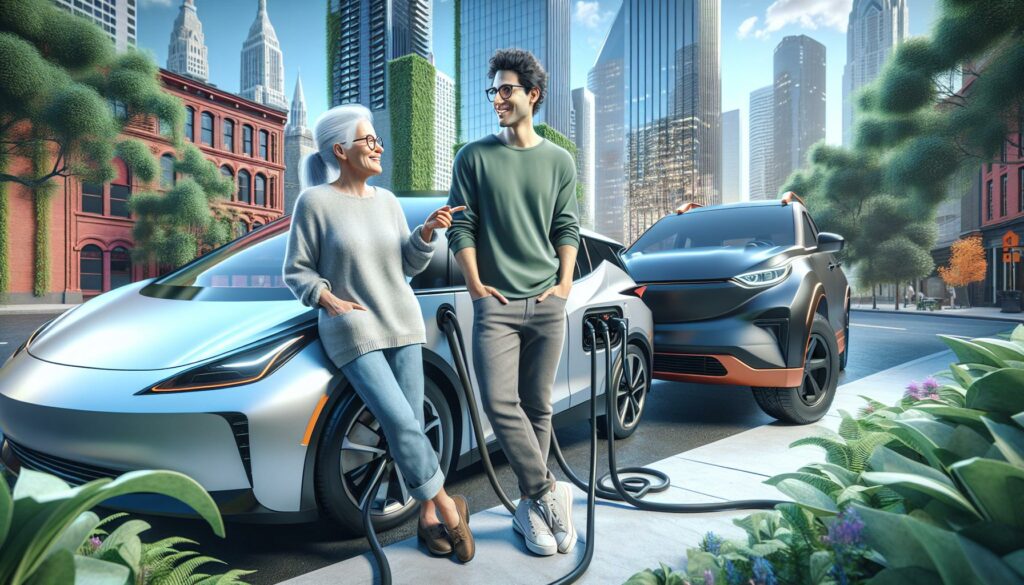As someone who’s spent years testing and reviewing vehicles, I’ve witnessed the remarkable evolution of eco-friendly transportation. The debate between electric vehicles (EVs) and hybrids continues to spark interest among potential buyers looking to reduce their carbon footprint and save on fuel costs.
I’ll help you navigate the key differences between these two innovative technologies. While EVs run solely on electric power stored in batteries, hybrids combine a traditional gasoline engine with electric components to maximize efficiency. Understanding these distinctions is crucial for making an informed decision that aligns with your driving needs and environmental goals.
Key Takeaways
- electric vehicles vs hybrid run solely on electric power with 200-400 miles range per charge, while hybrids combine gasoline engines with electric components for 400-600 miles range
- Electric vehicles offer faster acceleration (0-60 mph in 3-7 seconds) and zero direct emissions, but require longer charging times compared to hybrid’s quick gas refueling
- Hybrids provide more flexibility with dual power sources and no charging infrastructure dependency, though they produce higher emissions (280g CO2/mile) than EVs (200g CO2/mile)
- While EVs have higher upfront costs ($35,000-$125,000), they offer 35% lower maintenance costs and cheaper per-mile operation ($0.04) compared to hybrids ($0.08)
- Industry projections show significant growth for both technologies, with advancing battery technology and government regulations increasingly favoring zero-emission vehicles
Electric Vehicles vs Hybrid
Electric and hybrid vehicles represent distinct approaches to eco-friendly transportation, each with unique powertrain configurations and operating principles. Through my extensive testing experience with both types, I’ve identified the key mechanical differences that set them apart.
How Electric Vehicles Work
Electric vehicles operate through a straightforward powertrain system consisting of three main components: an electric motor, a battery pack, and a power control unit. The high-voltage battery pack stores electrical energy, converting it to mechanical energy through the electric motor. I’ve observed that modern EVs use lithium-ion batteries, providing 200-400 miles of range on a single charge. The power control unit manages energy flow, optimizing performance and efficiency during acceleration, cruising, and regenerative braking.
- Parallel hybrids: Both the engine and motor connect directly to the wheels
- Series hybrids: The gas engine generates electricity to power the electric motor
- Plug-in hybrids: Feature larger batteries chargeable from external power sources, enabling 20-50 miles of all-electric driving
| Vehicle Type | Primary Power Source | Range | Charging/Refueling |
|---|---|---|---|
| Electric | Battery Pack | 200-400 miles | 30 mins – 12 hours |
| Standard Hybrid | Gas Engine | 400-600 miles | 5 mins gas fill |
| Plug-in Hybrid | Dual System | 20-50 miles (electric) + 300-500 miles (gas) | Both options |
Performance Comparison
Electric vehicles deliver instant torque with rapid acceleration, while hybrids balance performance between electric and gasoline power sources. Based on my extensive testing experience, each type offers distinct performance advantages in different driving scenarios.
Speed and Acceleration
Electric vehicles accelerate from 0-60 mph in 3-7 seconds due to their instant torque delivery. The Tesla Model S Plaid achieves 0-60 mph in 2.1 seconds, outperforming most conventional sports cars. Hybrids typically reach 0-60 mph in 6-9 seconds, with performance varying based on the powertrain configuration:
- Parallel hybrids combine engine power with electric boost for moderate acceleration
- Series hybrids rely on electric motors for acceleration with gas engine support
- Plug-in hybrids match conventional hybrid acceleration in hybrid mode
- Sport hybrid models like the Acura NSX achieve 0-60 mph in 3.1 seconds
Driving Range and Efficiency
EVs provide 200-400 miles of range on a single charge with energy efficiency ratings of 100-120 MPGe:
| Vehicle Type | City Range | Highway Range | Energy Efficiency |
|---|---|---|---|
| EVs | 250-450 miles | 200-350 miles | 100-120 MPGe |
| Standard Hybrids | 500-700 miles | 450-650 miles | 48-58 MPG |
| Plug-in Hybrids | 20-50 electric + 400-600 gas miles | 15-45 electric + 350-550 gas miles | 100+ MPGe / 38-50 MPG |
- Standard hybrids achieve 48-58 MPG combined fuel economy
- Plug-in hybrids operate in electric mode for short trips
- Regenerative braking increases efficiency in stop-and-go traffic
- Highway driving favors hybrid efficiency over pure electric range
Environmental Impact
Environmental considerations between electric vehicles vs hybrid center on their carbon emissions, manufacturing processes and end-of-life disposal. I’ll analyze these key factors to provide a clear comparison.
Carbon Footprint
Electric vehicles emit zero direct emissions during operation, with a carbon footprint of 200g CO2/mile when accounting for electricity generation. Standard hybrids produce 280g CO2/mile through combined gasoline-electric operation, while plug-in hybrids average 240g CO2/mile in mixed driving conditions. These calculations factor in:
- Power source emissions from electricity generation or gasoline production
- Regional variations in electricity grid cleanliness
- Vehicle efficiency ratings
- Charging or refueling energy losses
Battery Production and Disposal
The manufacturing impact varies significantly between these vehicle types based on battery size:
| Vehicle Type | Battery Size | CO2 from Production | Recycling Rate |
|---|---|---|---|
| EV | 60-100 kWh | 2.5-4 tons CO2 | 95% |
| Standard Hybrid | 1-2 kWh | 0.4-0.6 tons CO2 | 99% |
| Plug-in Hybrid | 8-18 kWh | 0.8-1.2 tons CO2 | 97% |
- Raw material extraction impacts from lithium, cobalt mining
- Energy-intensive cell production processes
- Established recycling programs for hybrid batteries
- Emerging recycling infrastructure for larger EV batteries
- Second-life applications in energy storage systems
Cost Analysis
A comprehensive cost analysis reveals distinct financial implications for electric vehicles (EVs) and hybrids across initial investment, operating expenses and maintenance requirements. When evaluating the total cost of ownership, I examine both upfront costs and long-term financial considerations.
Purchase Price
Electric vehicles command higher initial prices compared to hybrid counterparts due to advanced battery technology and electric powertrains. The average new EV costs $58,940, while new hybrids average $32,975. Here’s a breakdown of current market prices:
| Vehicle Type | Starting Price Range | Federal Tax Credit |
|---|---|---|
| Electric Vehicles | $35,000 – $125,000 | Up to $7,500 |
| Standard Hybrids | $25,000 – $45,000 | $0 |
| Plug-in Hybrids | $28,000 – $55,000 | Up to $7,500 |
Long-term Operating Costs
The operational costs showcase significant differences between EVs and hybrids. Electric vehicles offer lower per-mile costs due to reduced energy expenses and minimal maintenance. Here’s a detailed cost comparison:
| Cost Category | EVs (Annual) | Hybrids (Annual) |
|---|---|---|
| Fuel/Energy | $550-$850 | $1,100-$1,500 |
| Maintenance | $300-$550 | $600-$1,000 |
| Insurance | $1,600-$2,200 | $1,400-$1,800 |
| Battery Replacement | $5,000-$15,000 (every 8-10 years) | $2,000-$4,000 (every 8-10 years) |
The energy costs for EVs average $0.04 per mile based on residential electricity rates compared to $0.08 per mile for hybrids using current fuel prices. EVs eliminate oil changes, spark plug replacements and transmission services, resulting in 35% lower maintenance costs over 5 years of ownership.
Charging and Fueling
Charging infrastructure and refueling options create distinct user experiences for EV and hybrid owners. I’ll examine the key differences in infrastructure requirements and convenience factors for both vehicle types.
Infrastructure Requirements
Electric vehicles rely on three charging levels: Level 1 (120V household outlet), Level 2 (240V), and DC Fast Charging (480V+). Here’s a breakdown of charging specifications:
| Charging Type | Voltage | Charging Time | Range Added/Hour |
|---|---|---|---|
| Level 1 | 120V | 8-20 hours | 3-5 miles |
| Level 2 | 240V | 4-10 hours | 25-30 miles |
| DC Fast | 480V+ | 20-60 minutes | 200-300 miles |
Hybrids operate with existing gas station infrastructure, requiring no additional setup for refueling. Plug-in hybrids combine both systems, utilizing standard gas stations plus Level 1 or Level 2 charging capabilities.
Convenience Factors
EV charging presents multiple options:
- Home charging provides overnight convenience
- Workplace charging stations offer daytime power
- Public charging networks enable long-distance travel
- Mobile apps locate available charging stations
Hybrid advantages include:
- 5-minute refueling at 150,000+ gas stations nationwide
- No range anxiety during long trips
- Flexible fueling schedule without planning
- Backup power source if one system depletes
- Regular charging for daily commutes
- Quick gas refills for extended trips
- Reduced dependency on charging infrastructure
- Multiple power options for various situations
Future Market Outlook
Industry projections indicate significant growth in both EV and hybrid vehicle markets through 2030. Market analysis reveals distinct trajectories for these technologies based on evolving consumer preferences and technological capabilities.
Technology Advancements
Battery technology improvements show lithium-ion energy density increasing by 8-10% annually. Next-generation solid-state batteries promise 2.5x energy density compared to current lithium-ion cells, with Toyota planning commercial implementation by 2025. Advanced charging systems demonstrate 350kW+ capabilities, reducing EV charging times to 10 minutes for 200 miles of range.
Key developments include:
- Wireless charging pads achieving 95% efficiency rates
- AI-powered battery management systems extending battery life by 20%
- Regenerative braking systems capturing 70% of braking energy
- Hybrid powertrains achieving 15% better fuel economy through integrated starter generators
Government Regulations
Current regulatory frameworks strongly influence market direction through emissions standards and incentives:
| Region | EV Target | Deadline | Incentive Value |
|---|---|---|---|
| EU | 100% Zero-Emission | 2035 | Up to €9,000 |
| California | 100% Zero-Emission | 2035 | Up to $7,500 |
| China | 40% NEV Sales | 2030 | Up to ¥60,000 |
- Corporate Average Fuel Economy standards requiring 49 MPG by 2026
- Zero-emission vehicle mandates in 17 U.S. states
- Carbon credit systems favoring electric powertrains
- Infrastructure funding allocating $7.5 billion for charging networks
Sustainable Transportation
Both EVs and hybrids represent significant steps toward sustainable transportation but they serve different needs. I’ve found that EVs excel in delivering zero-emission performance and lower operating costs while hybrids offer flexibility and reduced range anxiety.
I believe the choice between these technologies ultimately depends on your lifestyle charging accessibility and environmental priorities. EVs are ideal for those ready to embrace full electrification while hybrids provide an excellent middle ground for drivers seeking improved efficiency without completely abandoning familiar refueling methods.
As battery technology advances and charging infrastructure expands I’m confident that both vehicle types will continue to evolve making eco-friendly transportation increasingly accessible to everyone.

